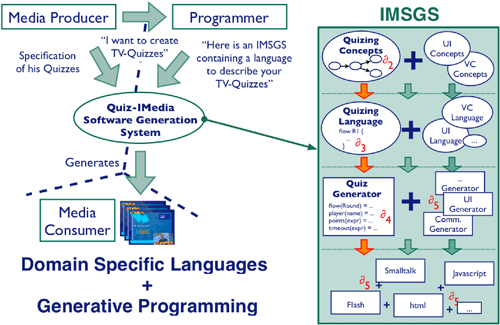
This issue in pdf Subscription Archive: Next issue: October 2005 |
|
||||
Software Automation meets Interactive Media Developmentby Dirk Deridder, Thomas Cleenewerck, Johan Brichau and Theo D'Hondt Developing the software component of interactive media requires an advanced set of development tools and enforces a different view on software development in general. This is mainly due to the specific characteristics of the environment in which this development takes place. We propose a combination of software automation techniques to counter this effectively. Since the iMedia domain is in continuous flux, and these technologies are mostly designed for stable domains, the evolvability of the approach is guaranteed by rooting it into the heart of the system. Media production companies, in particular media broadcasters, are being challenged by their consumers to produce media in which the consumers can actively participate and interact with TV shows and between peers. This new form of media, called interactive media, is a combination of traditional media and a behavioural component (software). Examples of such components are online games, quiz software, virtual community worlds etc. The challenge lies in the production of the behavioural component of the new form of media within the broadcasting environment. The production cycle is constrained by the imposition of extremely strict broadcasting times, the extremely short time-to-market situation caused by last-minute changes, and the extreme deployment prerequisites. IMedia Software Generation System Evolution of the IMSGS An IMSGS for a specific product range is divided into a set of program generators, each targeted at a specific concern in the product (eg the application logic, the graphical user interface etc). For each concern a domain model with CoBro is constructed that defines the concepts in the domain and the relationships between them. These models are then used to construct concise domain-specific languages (DSLs) compliant with the definitions in the domain model. The DSL compilers are program generators implemented in Linglet Transformation System (LTS), which translate the DSL specifications into executable code in some generic language using generic libraries and frameworks. Finally these program generators are composed using Generative Logic Meta-Programming (GLMP) in order to integrate each of their generated program parts into one application.
The domain knowledge is described in CoBro. CoBro follows a concept-centric approach in which we couple the domain concepts to their corresponding implementations in the quiz language. In this way, one can start at the level of the domain concepts to estimate which parts of the implementation (d3 in the figure) will be affected by the evolution (d2 in the figure). Moreover, connecting the domain knowledge to the implementation provides a valuable source of documentation of the assumptions made by the original developers. The DSLs are constructed using the Linglet Transformation System via a composition of language components, which is expressed in a language specification. LTS modularizes the language components by specifying the necessary communication patterns among them in a separated language specification, through the customization of the language components. Hence the dependencies among the language components become explicit and are removed from their implementations. Consequently the impact of changes in the language (d3 and d4 in the figure) is isolated to the language specification and to individual identifiable components. The composition of the program generators (DSL compilers) is realized with Generative Logic Meta-Programming. GLMP features a grey-box composition model of program generators that allows the specification of integration relationships among the subparts of different program generators. This mechanism is vital for adapting the generators so that they produce program parts; these can then be combined into a single application with no undesired interferences that could break their functionality (d5 in the figure). This research is performed in the context of the Advanced Media Project, a collaboration between Vlaamse Radio- en Televisieomroep, Vrije Universiteit Brussel, Universiteit Gent and IMEC. Links: Please contact: |
||||


